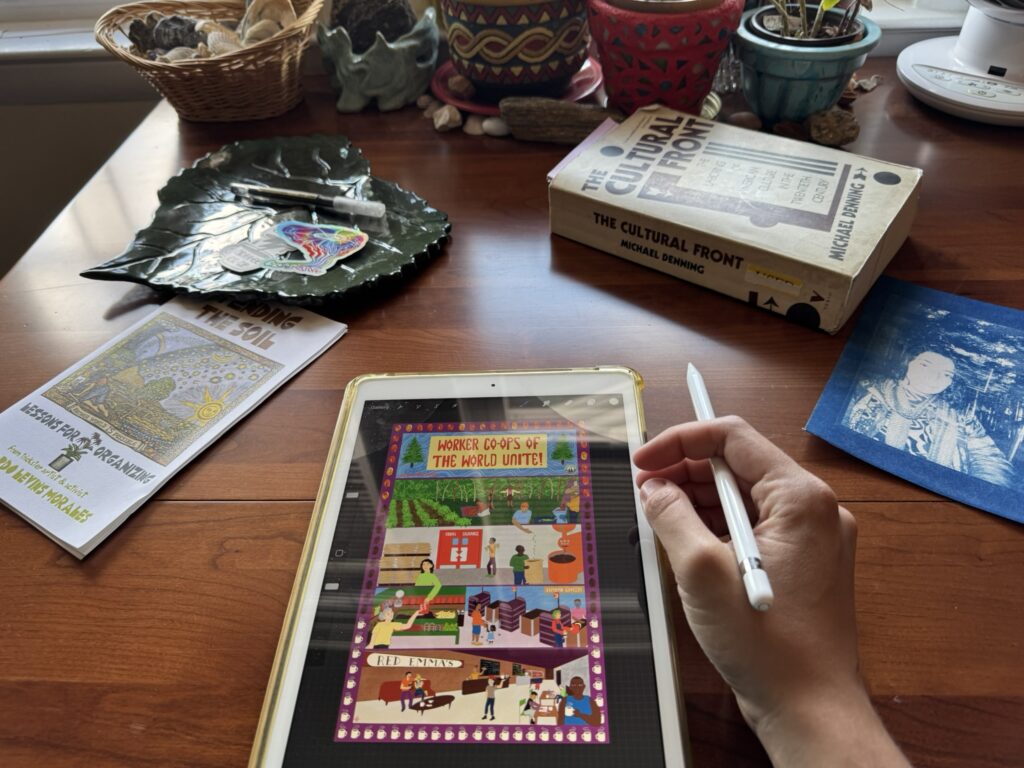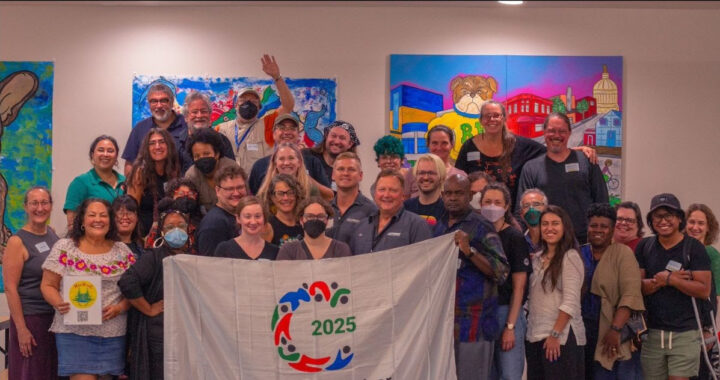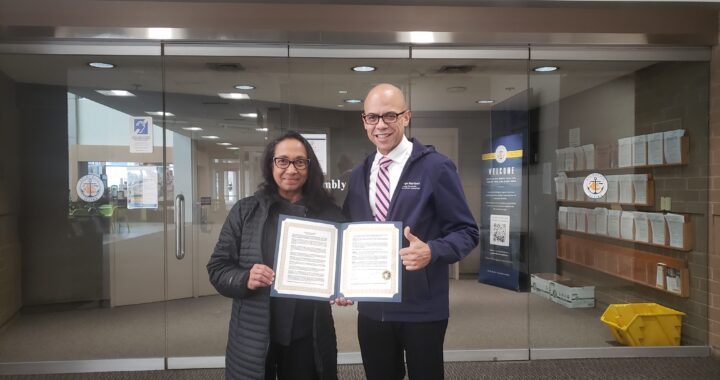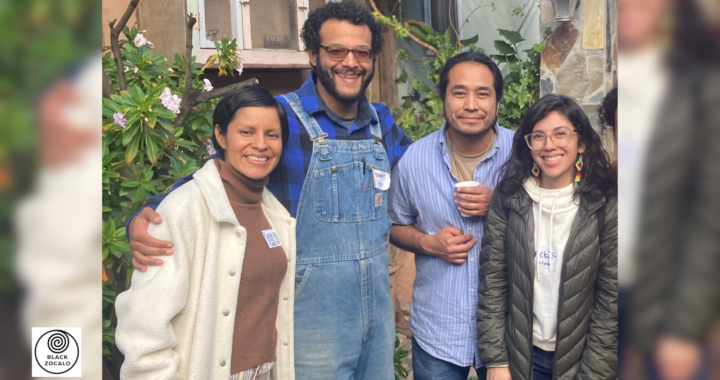Five questions with “Worker Co-ops of the World Unite!” poster artist Camila Tapia

In this blog, we share a short interview with Camila Tapia, the artist behind our new poster, “Worker Co-ops of the World Unite!”
Tell us about who you are and how this poster came about.
My name is Camila Tapia, and I’m the Training and Education Coordinator here at USFWC. I’m also a cooperative artist. By that I mean I have an artist worker-owned co-op called Transverse Cooperative, so I make art cooperatively, my art is often about cooperation, and I create art and design commissions for other co-ops. As I know the value of art for social movements, I offered to create art to represent USFWC in my capacity as a staff member. Art brings energy and life to the folks already doing the work, and it can attract new people in by sharing the beauty and stories of our movement. So, as the work of USFWC is bringing the national worker co-op movement together, I illustrated in this poster about how co-ops can be in cooperation with one another.
What does your co-op, Transverse Cooperative, do? Why did you all choose to form a worker co-op?
Transverse Cooperative is a start-up worker co-op based in Baltimore, MD, where we make art and design commissions for organizations doing social justice, collective liberation, and solidarity economy work. We’ve been working for the last three years with organizations all over the country to create comic books, posters, merch, logos, protest props, and more – and soon we’ll be doing our first mural as a collective for another local co-op. Our goal for the next year is to bring on more worker owners and get a space to have our studio, shop, and host events.
Under our current economic system, being a professional artist means some combination of pursuing wealthy patrons, branding your individual personality, accepting large financial risks to kickstart big projects, working without health insurance, and competing with other creatives for limited opportunities. And as activists and organizers, we knew there was a niche we were specifically fit for to make art, design, and cultural strategy an integral part of social movement work. So we collectivized our labor and all the risks that come with being an artist, and are working to thrive outside of the art-industrial complex.
In the poster, Cooperative Principle 6 (Cooperation Amongst Co-ops) is celebrated. Why is this important to you?
The 6th cooperative principle, aka P6, aka Cooperation Amongst Co-ops, is integral to my theory of change for worker co-ops as it speaks to how we can transform our economic system through co-ops by working together towards larger goals. P6 can be co-ops working in a supply chain together, sharing skills, knowledge, and resources, doing mutual aid or responding to calls for solidarity, using other co-ops for goods or services, or forming a wider network or organization together to meet collective needs and build power.
The USFWC facilitates P6 through our peer networks and member councils which connect worker co-ops together over industries and shared interests, our technical assistance which is carried out by Peer Advisors who are active, experienced worker-owners, and our conference which brings the national worker co-op field into one space.
As Transverse is a worker co-op, other worker co-ops often want to work with us since we understand this unique perspective and lived experience and we weave that into our art and process for working with folks. There’s also the aspect of our worker co-op clients being excited to work with us just to support another worker co-op, and because we prioritize contracting co-ops such as for our printing, which we often do with Radix Co-op.
How did you try to represent this in the poster, and what was your artistic process?
We wanted to celebrate the collective power of worker co-ops, and so I put the idea to other staff of what slogans I could build off of, and Michael Brennan who runs our Union Co-ops council came up with “Worker Co-ops of the World Unite!” From there I brainstormed with other staff about which way of co-ops cooperating would be the most interesting to depict, and we went with a worker co-op supply chain as we wanted to find a way to show off our members. After doing a good bit of research on our members and how they work together, I felt the coffee supply chain was the best one to illustrate as it’s a familiar process to people, they interact with coffee everyday, and the settings of each worker co-op in the chain are fairly visually unique.
The co-ops shown here are PRODECOOP, Equal Exchange, Rainbow Grocery, and Red Emma’s. I started with Equal Exchange as the coffee roaster since they have a wealth of information online about the co-ops they source their beans from and beautiful pictures to be inspired by. I paid homage to PRODECOOP, an agricultural cooperative that spans 38 villages in northern Nicaragua, as Equal Exchange cited Nicaraguan coffee growers as their oldest trading partner. Rainbow Grocery was featured as they actually sell Equal Exchange coffee, have been in operation for 50 years as of this year, and are all the way on the other side of the country in San Francisco, from Equal Exchange which is based in Massachusetts. While I did look into our members who are cafes and I couldn’t confirm a co-op cafe that brews Equal Exchange coffee, I knew that Red Emma’s here in Baltimore uses Thread Coffee, a worker co-op roastery based here in Baltimore that also uses international co-op coffee bean growers. Equal Exchange, Rainbow Grocery, and Red Emma’s are all fixtures in our co-op community and deserving of this celebration for the leadership.
The poster was a digital illustration inspired by many pictures online I could find of all of the co-ops, and I chose to show them interacting from one co-op to another, by passing the beans throughout composition, and ultimately having one character smiling at the viewer, enjoying the coffee. The composition changed a bunch throughout the process, and you can see the process video here:
In your own words, why are monthly donors important to USFWC?
Our member dues, monthly donors, and worker co-op specific funding such as WCBDI and RCDG make our work accountable fully to the worker co-op movement, as opposed to grants and funders from outside the movement. WCBDI and RCDG are being threatened to disappear and without these funding sources, not only USFWC but much of the worker co-op support ecosystem are under attack. With this in mind, we need more security and autonomy in our funding than ever. Monthly donors help keep USFWC accountable, growing, and independent.
For more info about Transverse Cooperative, check out their website at transversecooperative.com or get in touch with them at transverse.coop@gmail.com. To reach out to Camila at their USFWC email with any questions or comments, you can reach them at camila@usworker.coop


